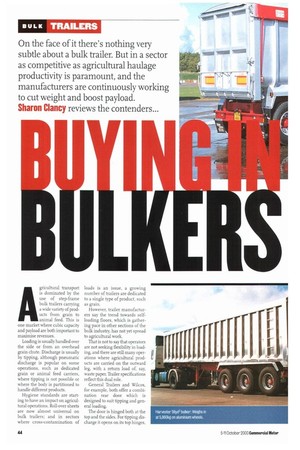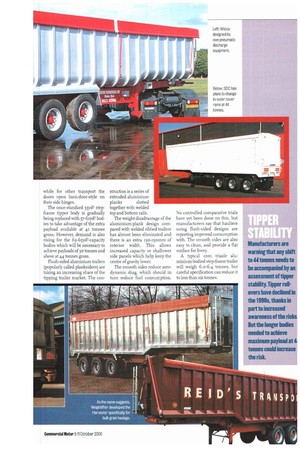On the face of it there's nothing very subtle about
Page 48

Page 49

Page 50

If you've noticed an error in this article please click here to report it so we can fix it.
a bulk trailer. But in a sector as competitive as agricultural haulage productivity is paramount, and the manufacturers are continuously working to cut weight and boost payload.
Sharon Clancy reviews the contenders...
Agricultural transport is dominated by the use of step-frame bulk trailers carrying a wide variety of products from grain to animal feed. This is one market where cubic capacity and payload are both important to maximise revenues.
Loading is usually handled over the side or from an overhead grain chute. Discharge is usually by tipping, although pneumatic discharge is popular on some operations, such as dedicated grain or animal feed carriers, where tipping is not possible or where the body is partitioned to handle different products.
Hygiene standards are starting to have an impact on agricultural operations. Roll-over sheets are now almost universal on bulk trailers; and in sectors where cross-contamination of loads is an issue, a growing number of trailers are dedicated to a single type of product. such as grain.
However, trailer manufacturers say the trend towards selfloading floors, which is gathering pace in other sections of the bulk industry, has not yet spread to agricultural work.
That is not to say that operators are not seeking flexibility in loading, and there are still many operations where agricultural products are carried on the outward leg, with a return load of, say, waste paper. Trailer specifications reflect this dual role.
General Trailers and Wilcox, for example, both offer a combination rear door which is designed to suit tipping and general loading.
The door is hinged both at the top and the sides. For tipping discharge it opens on its top hinges, while for other transport the doors open barn-door-style on their side hinges.
The once-standard 55yd3 stepframe tipper body is gradually being replaced with 57-Gryd3 bodies to take advantage of the extra payload available at 41 tonnes gross. However, demand is also rising for the 63-65yd3-capacity bodies which will be necessary to achieve payloads of 30 tonnes and above at 44 tonnes gross.
Flush-sided aluminium trailers (popularly called planksiders) are taking an increasing share of the tipping trailer market. The con
struction is a series of extruded aluminium planks slotted together with welded top and bottom rails.
The weight disadvantage of the aluminium-plank design compared with welded ribbed trailers has almost been eliminated and there is an extra 13o-i5omm of interior width. This allows increased capacity or shallower side panels which help keep the centre of gravity lower.
The smooth sides reduce aerodynamic drag, which should in turn reduce fuel consumption.
No controlled comparative trials have yet been done on this, but manufacturers say that hauliers using flush-sided designs are reporting improved consumption with. The smooth sides are also easy to clean, and provide a flat surface for livery.
A typical iorn triaxle aluminium-bodied step-frame trailer will weigh 6.0-6.4 tonnes, but careful specification can reduce it to less than six tonnes.
D Welded aluminium bodies can still offer a weight advantage, for example. Weightlifter has developed its lightweight welded Harvester body especially for grain haulage. An unladen 59yd3 Harvester running on alloy wheels weighs 5,860kg, which saves a useful 390kg on the standard step-frame bulk tipper.
Most of this saving comes from the use of thinner aluminium sheet (4mm on the sides with Gmm on the floor). The outside is ribbed to enhance rigidity, but the inside is smooth to save weight and help discharging.
"We can use thinner aluminium sheet because the body does not suffer the abuse that occurs with more abrasive loads such as aggregates," says sales director Richard Lancaster. "Payload potential increases to 27 or 28 tonnes at 41 tonnes gross."
General Trailers developed the concept of the so-called bath-tub trailer with outer supporting ribs and a tipping ram that is recessed into the body front bulkhead. This saves weight but imposes more of the tipping force directly over the kingpin, so it could become more common for 44tonne operations.
Bath-tub step-frames are also offered by Wilcox, whose design won Commercial Motor's 1998 trailer of the year award.
LIFT AND STEER AXLES
For operations where access may be restricted, such as farm deliveries of animal feed, Dennison Trailers offers positive-rear-steer systems that give manoeuvrability that is said to be as good as a rigid, if not better.
Available as a production option, it is a mechanical system featuring a front turntable with a steering wedge which fits inside the fifth wheel, and a rear turntable onto which the trailer's rearmost axle is mounted.
A steer arm connects the front turntable to a pivoting steering assembly linked by rods running along the length of the trailer to the rear turntable, which guides the axle in line with the vehicle. The system is virtually maintenance free, with no greasing points, hydraulics or electronics.
Self-tracking axles may prove popular at 44 tonnes CVW by helping eliminate tyre scrub, which can be a problem with longer trailers.
PNEUMATIC DISCHARGE
On dedicated pneumatic. discharge tippers, operators are demanding tooyd3 plus, but the discharge equipment needs to be tailored to suit the load.
"The speed of the air has to be matched to the product," says Marcus Leyton, sales director at Wilcox, the bulk specialist in the United Trailers group. "It's a careful balancing act. A high airflow speeds up discharge, but if it's too fast there is risk of the product breaking up."
Wilcox has designed its own pneumatic discharge equipment, including seals and hydraulic couplings, to protect the product and improve reliability of the equipment. The system is based on a Roots-type rotary blower in which the air is under pressure all the time.
Some manufacturers use an auger to move the product but Wilcox prefers an angled discharge blade which is designed to gather the product in to the discharge trough, rather than push it. The company says this causes less damage to the product.
TEMPERATURECONTROLLED
Farmers and fresh food distributors are increasingly being asked to deliver produce in temperature-controlled trailers.
Everard & Son and RS Cocker are the two main contractors for potato deliveries to snack food manufacturer Walkers Crisps. The work is now handled with 33 General Trailers Iceliner temperature-controlled trailers featuring standard 45mm-thick insulated panels but no refrigeration unit.
Walkers has changed the spedfication to protect the potatoes from frost damage in the winter and sweating during higher summer temperatures which can cause bruising. There is also less risk of cross-contamination between products. All the potatoes are loaded by conveyor. Unloading at Walker's Peterlee factory is via an internal tipping platform; the potatoes at Leicester are washed out using a high-pressure water jet.
Even more ingenious is the Rouse & Beer design, which was also developed for potato deliveries into a leading food processor (and won the bulker class in CM'S 1999 Trailer of the Year awards). It preserves the loading and unload
ing flexibility of a tipping trailer, while giving some temperature protection to sensitive products.
The 65yd3 trailer looks like a standard step-frame pressed-aluminium monocoque body. It is made of 4mm plate with a 6mm floor, deepening to 8mm at the rear. The insulation comprises slab polyurethane insulation between the uprights, and polyurethane-injected foam in the uprights. The insulation is held in place by r8-gauge aluminium sheet. Two Dawbarn roll-over sheets are fitted with flexible insulation between them.
Temperature control comes from a Thermo King WKD2 refrigeration unit mounted in a specially designed recess in the headboard. It has an isolator switch to prevent fuel flow to the unit during tipping operations.
















































































































